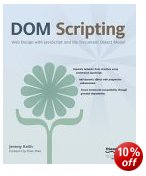I wrote a post back at the end of 2005 called "Essential Reading for Web Designers" in which I wrote about a few books that I considered essential reading for anyone who does website design. Primarily these books focused on using web standards, at the time these books were the few key books about this subject.
Since then a lot more books have been written but the books I wrote about then are still very important. In fact two of them have been updated with a second edition bringing them right back up to date with the current state of web design. As these second editions have come out I thought I’d make a second edition of my own and update my list of essential reading too!
 Designing with Web Standards – Second Edition by Jeffrey Zeldman
Designing with Web Standards – Second Edition by Jeffrey Zeldman
This second edition by an author who was recently called ‘The King of Web Standards’ in a recent interview on BusinessWeek.com brings this key book up to date. the back cover states:
Best-selling author, designer, and web standards evangelist Jeffrey Zeldman has updated his classic, industry-shaking guidebook. This new edition, now in full color, covers improvements in best practices and advances in the world of browsers since the first edition introduced the world to standards-based design.
View Designing with Web Standards – Second Edition on Amazon.
 Bulletproof Web Design: Improving flexibility and protecting against worst-case scenarios with XHTML and CSS, Second Edition by Dan Cederholm
Bulletproof Web Design: Improving flexibility and protecting against worst-case scenarios with XHTML and CSS, Second Edition by Dan Cederholm
This second edition, due for release in September 2007, updates this excellent book. Dan writes about it on his own website saying:
This isn?t a giant update nor a new book entirely. Rather, it brings the examples in line with Internet Explorer 7 (which wasn?t released when the first ed. was published) and adds several more examples based on ems (which were sorely lacking from the original book). There are of course errata fixes and nips and tucks throughout as well, and about 30 additional pages were added in total.
 DOM Scripting: Web Design with JavaScript and the Document Object Model by Jeremy Keith
DOM Scripting: Web Design with JavaScript and the Document Object Model by Jeremy Keith
This book focuses on best practices for Javascript coding. It’s a great book aimed at web designers rather than programmers so it’s an excellent way to get into the power that the DOM and Javascript can offer:
The book is aimed at designers rather than programmers. If you’ve learned the benefits of Web Standards through CSS and you’re now ready to move on to the next level, this is the book for you. It will show you how to add stylish, usable enhancements to your web pages using Web Standards that guarantee future compatibility.
View DOM Scripting: Web Design with JavaScript and the Document Object Model on Amazon.
 Bulletproof Ajax by Jeremy Keith
Bulletproof Ajax by Jeremy Keith
Following on from DOM Scripting, Jeremy Keith writes further about best practices in Javascript programming. This book focuses on how to use AJAX but in a way that degrades well and is accessible:
Using flexible design elements that adapt to the user?s needs, Web sites continue to work beyond the typical browsing environment. I believe that the same philosophy can be applied to Ajax. Far too many Ajax applications are built like a house of cards, dependent on just the right stack of technologies in the browser. Browsers that don?t support the required technologies are locked out and their users are turned away. To avoid this, you need to create flexible applications using bulletproof Ajax.
View Bulletproof Ajax on Amazon.
And many more…
These are just a few books on these subjects, but they are a few that I would definitely recommend reading, and probably in the order I’ve listed them too. A quick look on Amazon (or in my Amazon aStore found under the ‘Store’ section above) will find many other books to take your web design and development further.
~Rick
 This book is the one to read if you don’t know anything about Web Standards at all, it’s intended more to explain the benefits of Standards compliant web design rather than being a how-to manual with extensive code.
This book is the one to read if you don’t know anything about Web Standards at all, it’s intended more to explain the benefits of Standards compliant web design rather than being a how-to manual with extensive code. For those who’ve read the first book and have gotten hooked then this next book is a great way to move forwards. There’s lot’s of practical code examples which relate to real world usage, it gives solutions that can be applied to give great results.
For those who’ve read the first book and have gotten hooked then this next book is a great way to move forwards. There’s lot’s of practical code examples which relate to real world usage, it gives solutions that can be applied to give great results. The next book follows on from the previous book and focuses on ‘bulletproof’ techniques to use in building your sites.
The next book follows on from the previous book and focuses on ‘bulletproof’ techniques to use in building your sites. The title of this book might sound a little ominous, maybe all of them do?!?! This book is a great companion to the rest in that as the other books deal more with Standards Compliant CSS and XHTML this book focuses on Standards Compliant Javascript coding.
The title of this book might sound a little ominous, maybe all of them do?!?! This book is a great companion to the rest in that as the other books deal more with Standards Compliant CSS and XHTML this book focuses on Standards Compliant Javascript coding.